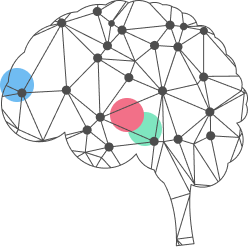![]()
Why We Think and Do the Things We Do
Welcome to the first lesson! Let’s start by looking at some key parts of the brain, how they influence our thoughts and actions, and why we sometimes feel like we don’t quite understand why we do what we do.
The Basics Parts of the Brain
Here are a few main parts to know:

 The Amygdala This is your “alarm system⚠️.” It reacts quickly to anything that seems dangerous or stressful and often triggers “fight or flight.”
The Amygdala This is your “alarm system⚠️.” It reacts quickly to anything that seems dangerous or stressful and often triggers “fight or flight.” The Prefrontal Cortex (PFC) This is the “thinking 🤔” part of your brain. It’s responsible for planning, reasoning, and decision-making. Think of it as your inner “CEO.”
The Prefrontal Cortex (PFC) This is the “thinking 🤔” part of your brain. It’s responsible for planning, reasoning, and decision-making. Think of it as your inner “CEO.” The Hippocampus This part helps store memories 🗄️. It’s why you can remember your past, and it helps you learn from your experiences.
The Hippocampus This part helps store memories 🗄️. It’s why you can remember your past, and it helps you learn from your experiences.
Why We Don’t Always Know Why We Do Things
Often, we think we’re acting for logical reasons, but many of our actions come from emotions first. The brain’s “thinking” side (Prefrontal Cortex) often follows the “feeling” side (Amygdala) by coming up with reasons that sound good but aren’t really the true motivation.
For example, have you ever found yourself eating dessert even after deciding to skip it? The emotional brain said, “I need a treat,” while the thinking brain came up with, “I deserve a reward after today.” In reality, the emotional need came first, and then we layered on a reasonable explanation afterward.

The Two Systems: Fast and Slow Thinking
Psychologist Daniel Kahneman describes two ways our brains work:
- System 1 (Fast Thinking) – This is the brain’s automatic, quick-response mode. It makes snap judgments and relies on feelings and instinct.
- System 2 (Slow Thinking) – This is the more deliberate, thoughtful mode where we carefully weigh pros and cons.
Most of the time, we’re in System 1. This is efficient, but it also means we make quick decisions that may not always make sense logically. System 2 helps us slow down and make more rational choices, but it takes energy, so we switch to it only when really needed.